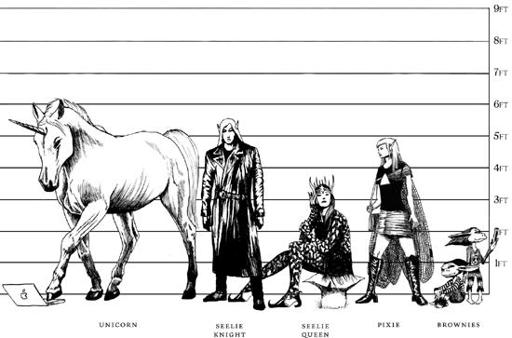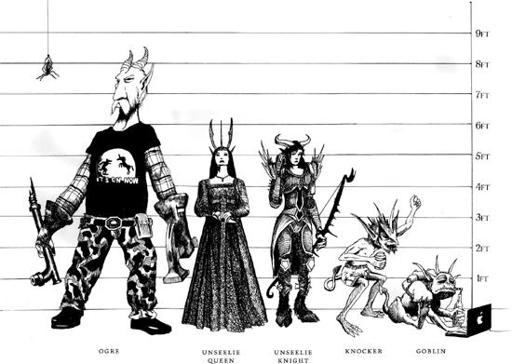The Shadowhunter's Codex (17 page)
Read The Shadowhunter's Codex Online
Authors: Cassandra Clare,Joshua Lewis
Tags: #Juvenile Fiction, #Horror & Ghost Stories, #Lifestyles, #City & Town Life, #Fantasy & Magic, #Social Issues, #New Experience, #Paranormal

Hey baby, guess where my warlock mark is.
Never works. Trust me. Never works.
IFRITS
Rarely, but sometimes, a warlock is born who, though the child of a demon and a human, has no access to demonic magic. These unfortunate souls have the disadvantages of a warlock—the warlock aspect that marks them as not fully human—but cannot perform magic. These so-called ifrits are trapped on the limens of the magical world, suffering the stigma of their inhuman marks without the benefit of supernatural power. Historically they have fallen into the underclass of the supernatural world, and are often found working on the wrong side of the Law, unable to live in the mundane world but unable to find a respectable life in the Shadow World.
Sometimes, of course, an ifrit is born with a warlock mark that can be easily hidden from public view. These “ghost ifrits” can sometimes make their way through mundane human society without complication, and as such may have no doings with the Shadow World at all. Today most ifrits with marks that are difficult to disguise acquire magical artifacts that provide them with a permanent glamour and live away from the magical world, unable to have children of their own but otherwise unremarkable to mundanes.
FAERIES
Note: The Fair Folk are not actually fair. They are big cheaters in fact.
Strange they may be, alien to us, more unknown than demons themselves, but the fey, the faeries, are Downworlders. They are people—they have souls. They are the least understood of all magical peoples, the great ancient mystery of our world. They are found in countless varieties, sizes, and types, and in all environments.
Most properly these creatures are known as “faeries,” after their homeland, the realm of Faerie. They are known in literature by many other names, partly because of their enormous variety and partly because of age-old superstitions about invoking them by name. Most commonly they are called the fey, but you will also hear them named the Fair Folk, or the Kind Ones, or the Little People, or any number of other euphemisms.

IF YOU MEET A FAERIE
Do not sign any contracts or agree to any bargains with faeries. Faeries love to haggle but will usually do so only if they are sure they will win. Do not eat or drink anything a faerie gives you. Do not go attend their magical revels under the hills. They will paint a beautiful picture of what awaits you there, but its beauty is false and hollow. Do not tease a faerie about their height. Do not expect direct answers to direct questions. Do expect indirect answers to indirect questions.
Faeries will always exactly follow the letter of any promise they have made, but expect results delivered with great irony.
Many Shadowhunters have been taken in, despite these rules, by a belief that the particular faerie they met was simpleminded, naive, generous, and so on. This playacting is yet another ploy.
This is a little harsh. Faeries not that bad.
I don’t think I agree!
WHERE DO FAERIES COME FROM?
The fey are originally the offspring of demons and angels, with the beauty of angels and the viciousness of demons. (Obviously, since angels are rarely if ever seen in our world in current times, the vast majority of faeries are the offspring of other faeries, just as most Shadowhunters are the offspring of other Shadowhunters and not born from the Cup.) The Fair Folk cannot be said to be morally aligned with either of their parent races. They are good and evil tangled up, following neither the morality of Heaven nor the immorality of Hell but rather their own capricious code of behavior. They are known for their cunning and their cruel sense of humor, and they delight especially in tricking humans—mundanes and Shadowhunters alike. They frequently seek to bargain with humans, offering someone his heart’s desire but failing to mention that that desire comes with a terrible cost. They are very long-lived and become only more artful and powerful as they age.
They are the other Downworlders, along with werewolves, who can bear children. They can also have offspring with humans. These offspring will be human and not fey, but they often retain some faerielike aspects or have a penchant for certain kinds of fey magic. It’s widely believed, for instance, that humans who naturally possess the Sight have inherited it from some faerie ancestor.
As with werewolves, the children of faeries and Shadowhunters will be Shadowhunters.
Although the fey are active members of Downworld, and signers of the Accords, faeries are more removed from the affairs of our world than any other known creatures except angels. They usually keep to themselves, and have their own complex politics and social structures, which only tangentially affect our world.
Commonly they are organized into courts, with sovereigns presiding over specific territories in our world and in theirs. However, there are just as many, if not more, free-ranging faeries in the world unaffiliated with any specific monarch. Just as the fey delight in manipulating humans, they delight in manipulating one another, and usually if the problems of the fey intrude into our world, it is the result of conflicts between rival courts, sometimes playful, sometimes serious and brutal.

FEY AND MAGIC
The magic of the fey is, as far as we know, unique in the world. It is very powerful but neither demonically nor seraphically allied, and it cannot be learned or wielded by any creatures other than the fey themselves. This magic is slippery and chaotic and is not easily given to structure and rules that can be learned. Nephilim Marks exist that can protect you from faerie glamours, but you should never, ever allow yourself to feel safe or at ease in the presence of faeries. Believing yourself to have the upper hand in a negotiation with a faerie is a sure sign that you are being deceived and will suffer for it in the end.
Why, then, if they are so removed from our world, do the fey continue to interact with humans as much as they do? The answer lies in genetics.
The biggest problem facing the fey in our modern world is the thinning of their blood. Over time the problem of extensive interbreeding leads to the weakening of family lines. For this reason faeries spend much of their time luring humans into their world. They pursue this in two ways: by creating changelings (see below) and by enticing adult humans into their revels. Much faerie magic exists to trap these reveling humans in Faerie forever, or at least for a long enough time that either they “go native” and forget their former lives or they can be used to produce new faerie children.
There are ways for mundanes (and Shadowhunters) to successfully join the faerie revels without trapping themselves in Faerie. A faerie could be convinced (or bargained with) to give a human a token of safe passage—usually something like a leaf or a flower. And a faerie who voluntarily brings a specific human to the revels can offer his protection and guarantee the human’s ability to leave. These bargains, however, are subject to the usual faerie trickery and duplicity, and mundanes and Shadowhunters alike should beware.
CHANGELINGS
The most common contact that the fey have with mundanes is in the making of changelings. It is not dissimilar from the manner whereby the Nephilim create new Shadowhunters with the Mortal Cup, but in the case of the fey, the mundanes gain no benefit. The faeries sneak into a mundane home, take a suitable child, and replace it with a sickly member of their own race. The human child thus grows up in Faerie, able to bring fresh strong blood into the faerie lines, while the mundanes find themselves forced to parent a dying child terrified of iron. It’s generally believed that the faeries exchange one of their own partly to allay the suspicions of mundanes and partly out of a twisted, and very fey, sense of fair exchange.
By some method unknown to us, mundane children raised in Faerie take on fey attributes, and can perform some faerie magic. By the same token the fey child left in the mundane world, if he survives, typically never knows his own origin. Apart from a predilection for the Sight, he may never come to know anything of the magical world at all.
By Covenant Law we are forbidden from interfering with this process of child exchange. This ruling has been debated hotly at several of the Accords proceedings over the past hundred years, but both of the children are raised in loving homes—the fey choose the unwitting adoptive parents of their offspring carefully—and no better solution for refreshing the faerie bloodlines has been found. Pragmatism leads Nephilim to prefer that the fey create changelings rather than abduct adult mundanes into their revels.
THE LAND OF FAERIE
The realm of Faerie is not one that is welcoming to Shadowhunters, and in general Nephilim should avoid spending time there. Despite our powers and our Sight, we are still as susceptible to the lures and dangers of Faerie as most mundanes. The fey have always been clear that their signing of the Accords represents their covenant for behavior in our realm, not in theirs. Faerie is older than the Accords, older than the Nephilim, and it possesses its own magic that the Gray Book can only partly and imperfectly protect against, at best.
That said, Faerie does have rules, and those rules do not leave Nephilim helpless. A Shadowhunter who is the victim of an unprovoked independent attack by a creature of Faerie is allowed by fey law to defend herself. If the attacking creature is killed, the fey are likely to shrug and explain that the creature’s decision to attack was his own, and if that decision turned out poorly, it was not the problem of other fey. (One must, of course, be careful that such an attack is not on the orders of some other creature or court; it is always worth remembering that the only thing that the fey like more than meddling in human affairs is their own internal political fights. A Shadowhunter who became a piece in one of the faeries’ elaborate games of human chess would be very unlucky indeed.)
Other books
9781631054631ChoiceAffairsSalisbury by Jamie Salisbury
Maggie MacKeever by Sweet Vixen
Highlander's Prize by Mary Wine
Deadly Alliance by Kathleen Rowland
1416934715(FY) by Cameron Dokey
The Last Undercover by Bob Hamer
Dirty Shots by Marissa Farrar
Trump and Me by Mark Singer
The Strange Adventure of Maria Mercado by Jenell Diegor
Ghost Memory by Maer Wilson
